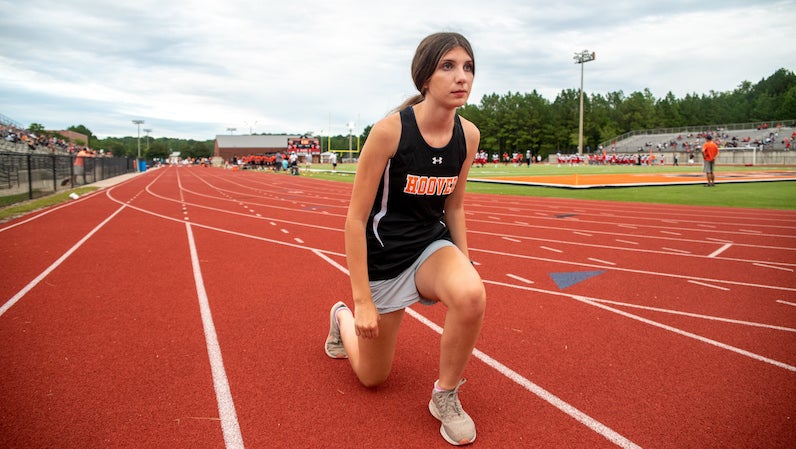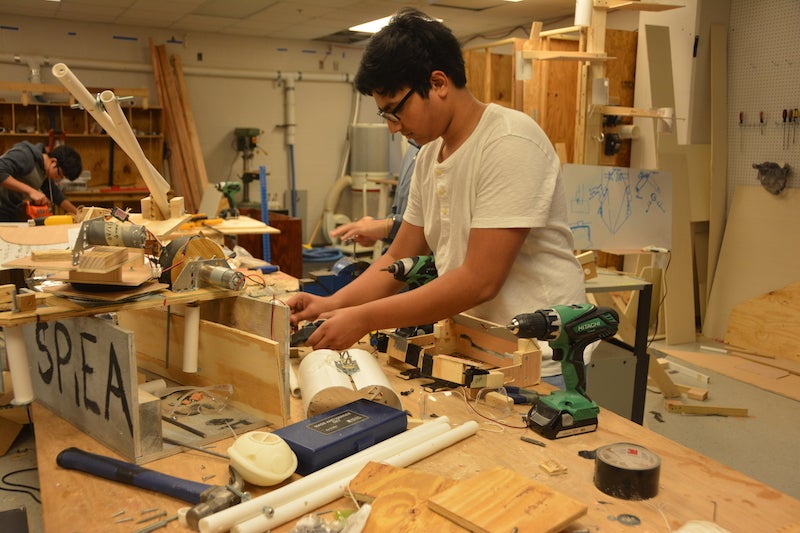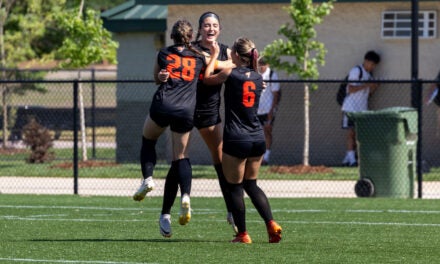Hoover High School junior Lauren Harding-Smith was going to breakfast on the last morning of her family’s spring break ski trip to Salt Lake City, Utah, in 2019 with nothing more on her mind than the time she had logged on the slopes that week. Her father, Alistair, was feeling relieved everyone had made it through the trip uninjured. But as they checked in at the restaurant, he noticed Lauren didn’t respond to a question, an incident he initially dismissed as Lauren being absent-minded as a 15-year-old still on vacation. It had been a busy week.
They sat at a table and started giving the waitress their orders. That’s when the confusion set in for Lauren. “I kept missing parts of her sentence,” she says. “I couldn’t hear it.” Lauren’s eyelids began to flutter, which her brother noticed and pointed out to their dad. “It became clearer that she was not fully there and responding,” Alistair says. “When the waitress noticed, I became concerned, but thought it was just oxygen.”
Oxygen. That had to be the issue. Oxygen levels are lower than normal at ski resorts like those in Salt Lake City, leading some people to experience symptoms of altitude sickness. Maybe that’s what had happened to Lauren, he thought, until one of the paramedics tending to Lauren mentioned his daughter’s experience with seizures and that he recognized similarities between hers and Lauren’s symptoms. All of a sudden, the gravity of the situation set in. Alistair took the paramedic’s advice and approved for Lauren to be taken by ambulance to the hospital. About 10 minutes before they arrived, Lauren had a grand mal seizure – a type of seizure involving loss of consciousness and muscle contractions.
Lauren’s memory of her hospital stay is foggy, but her diagnosis cut through the haze: juvenile absence epilepsy. When her family arrived home, they set up an appointment at Children’s of Alabama for further testing. Lauren had an electroencephalogram, or EEG, done to record her brain activity and determine what was triggering her seizures. She wasn’t sensitive to lights, but she did react to hyperventilation and oxygen changes. That explained her seizures in Salt Lake City.
“The event of her grand mal seizure was shocking and frightening to say the very least, but having a quick and accurate diagnosis for her condition was a real relief,” says Lauren’s mother Daphne Harding-Smith. “Even though there are so many types of epilepsy and it’s a very individualized experience, there are successful treatments for controlling the types of seizures Lauren experiences that can help her have as much of a normal life experience as possible.”
Lauren’s doctors started her on an anti-seizure medication and asked her to come back in for another EEG to test its effectiveness. The EEG still showed seizure activity, so they bumped up her dosage. Next she underwent a 48-hour EEG, which required her to wear wires attached to her head and trailing down into a backpack. Her brain was still showing seizure activity, so her dosage increased again. The cycle of tests and medication adjustments continued, but the ultimate goal remained the same: for Lauren to be seizure-free.
Throughout the daunting process, running remained a constant in Lauren’s life. She has traversed tracks and cross-country courses since middle school, relishing the longer distance races that require pacing and endurance. Her doctors told her she could continue running as long as she had emergency medication onsite with a school nurse, stuck to safe trails without cliffs and didn’t run alone. She was fine with these conditions.
What she had to adjust to was the mental aspect of her diagnosis; knowing she has epilepsy and that she could have a seizure while running. The chances are low but are there nonetheless. “I was a lot more nervous,” she says. “I was always thinking, ‘Did I take my medicine this morning? What if I get to the point where I start breathing too hard and I have a seizure?’ It’s easy to not be logical when you’re nervous. The what-ifs … that was the most difficult part.”
But Lauren draws comfort from knowing she’s not alone in being a runner who copes with a health issue at her school. She considers herself fortunate to have reached a point where her seizures are controlled. And if she were to have a seizure during practice, her teammates know when to call for help. “We have to make sure her teachers, coaches and friends are aware of what to look for—and she knows to listen to her body and be mindful,” Daphne says. “With epilepsy you can have an ‘aura’ or a feeling that a seizure is coming. So there are certainly precautionary procedures we have to do, and that takes time and effort, but they enable her to have the freedom to do things like compete.”
Alistair praised Lauren’s teammates and coaches for their support and encouragement, and adds, “Cross country and running have been so important to her through this. It has helped her have a focus and feel like the normal teenager that she is.” The “normal” part is what her parents want for her more than anything—even if her new normal looks different than it used to. “When I see the bottles of medication in her bathroom and knowing that for now and possibly the rest of her life she has to rely on it and be extraordinarily responsible for herself, it’s a feeling of sadness for her, for her loss of the ability to be carefree in her young age,” Daphne says. “She had to step up and become more responsible and adopt a lifestyle change that doesn’t allow her to be carefree to some extent.”
For Lauren and her family, the last year has been equal parts eye-opening and inspiring. “I knew so little about epilepsy, how many types there were and how many more people had a form of epilepsy than I would ever have guessed,” Alistair says. “Lauren was such a high performer academically and athletically that it was hard to imagine that she most likely had been dealing with this for a while.” Daphne says the “absence” seizures Lauren was suffering from before her grand mal seizure were so subtle that they were nearly undetectable. “It just looks like she’s daydreaming for 10 or 20 seconds or so, then she snaps back into it. I started noticing it being more than just daydreaming about six months before her grand mal seizure because it looked like she was rolling her eyes at me like a sassy teenager. But that was in fact the seizure causing her eyes to twitch for a few seconds.”
Lauren had to be seizure-free for at least six months to be cleared to drive a car and eventually get her driver’s license—an important rite of passage for any teenager. After more than a year of waiting, she finally got that much-anticipated plastic card this summer. “Now that it is controlled and she has had no seizure, I’m just delighted she can drive and live a normal high school life,” her dad says. “Her goal is to place top five in girls varsity at Hoover at a meet. My hope is that we can gradually reduce medicines and that it is something that she will grow out of over time.”
Daphne says Lauren embraces her uniqueness and views her condition as an opportunity instead of a setback. Her self-discipline and focus are evidence of that. “She is very competitive, hard-working and determined,” Daphne adds. “I am certain that my daughter will have the greatest of success in her life, in whatever she chooses to do. I don’t see her as having limitations of any sort. And she doesn’t either. She will always make the best of any situation and will be stronger for it. The future looks very bright for her for sure.”
A Community of Support
Since her diagnosis last year, Lauren has become involved with the Hoover-based Epilepsy Foundation of Alabama, a chapter of the national Epilepsy Foundation of America that develops and implements programs and services for people with epilepsy. She has been able to connect with others her age coping with epilepsy and learn about the Foundation’s efforts to promote research. “Also, one thing the Epilepsy Foundation is really pushing is for the ability of not just nurses to be able to administer the anti-seizure meds,” Alistair says. “It really does not need a nurse, but this limitation means some schools limit activities of kids with epilepsy when that would not be necessary.” For more information, visit EpilepsyAlabama.org.










